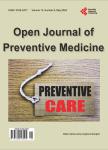Understanding Health Worker Perspectives on Risk Screening for HIV Testing—A Qualitative Study from Zimbabwe
Understanding Health Worker Perspectives on Risk Screening for HIV Testing—A Qualitative Study from Zimbabwe作者机构:Department of Primary Health-Care Sciences The University of Zimbabwe Harare Zimbabwe Ministry of Health and Child Care AIDS and TB Unit Harare Zimbabwe Organisation for Public Health Interventions and Development (OPHID) Harare Zimbabwe Clinton Health Access Initiative (CHAI) Harare Zimbabwe
出 版 物:《Open Journal of Preventive Medicine》 (预防医学期刊(英文))
年 卷 期:2022年第12卷第10期
页 面:199-212页
学科分类:1002[医学-临床医学] 100214[医学-肿瘤学] 10[医学]
主 题:Screening Tool Qualitative HIV Testing Services Health Worker Perspectives Grounded Theory Framework
摘 要:Background: Zimbabwe recorded a 55% increase in HIV testing from 2011 to 2018 but with decreasing HIV-testing yields from 20% to 6% respectively as we aim to identify the narrowing gap of undiagnosed people living with HIV. As such adoption of screening tools during targeted HIV testing services improves efficiency by identifying individuals who are likely to test positive. Effective utilization of screening tools requires an understanding of health care worker perception and willingness to use the tools. Methods: We conducted a qualitative study among healthcare workers at 8 selected primary healthcare facilities in Zimbabwe. Interviewer-guided, in-depth interviews were conducted with healthcare workers and their immediate supervisors. Thematic analysis was performed following a framework built around the grounded theory model to describe perspectives that influence the utilization of HIV screening tools and suggestions for improved eligibility screening. Results: Behavioural factors facilitating the utilisation of the screening tool included motivation to adhere to standard practice, awareness of screening in targeting testing, and its ability to manage workload through screening out ineligible clients. This was evident across service delivery levels. Barriers included limited healthcare capacity, confidentiality space, multiple screening tools and opaque screening in/out criteria and the potential of clients not responding to screening questions truthfully. Conclusions: Across geographical and service delivery levels, placing screening tools at HIV testing entry points, healthcare worker knowledge on screening in/out criteria emerged as enablers for correct and consistent utilization. Further, standardizing the tools and adopting a decision aid algorithm would improve the accurate utilisation of screening tools.



